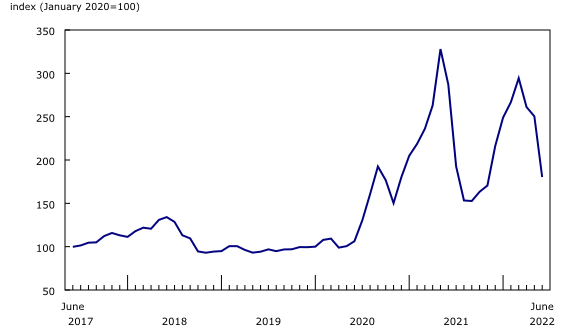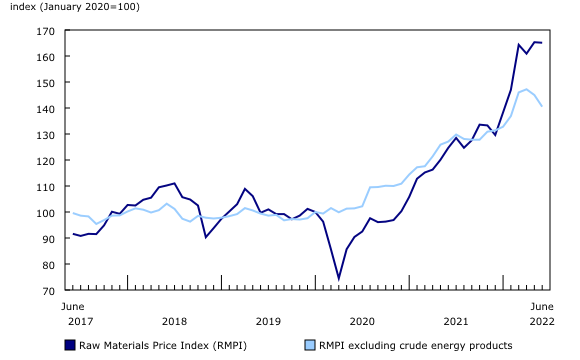Industrial product and raw materials price indexes, June 2022
Released: 2022-07-20
Prices of products manufactured in Canada, as measured by the Industrial Product Price Index (IPPI), declined by 1.1% month over month in June 2022 and were 14.3% higher than in June 2021. Prices of raw materials purchased by manufacturers operating in Canada, as measured by the Raw Materials Price Index (RMPI), edged down 0.1% on a monthly basis in June 2022 and increased 32.4% year over year.
Industrial Product Price Index
In June, the IPPI declined 1.1% month over month and was 14.3% higher than in June 2021. This was the first monthly decline in the IPPI since August 2021 (-0.3%).
The decline in the IPPI was mostly driven by a 28.0% drop in softwood lumber prices. This was the third consecutive monthly decrease for softwood lumber and the largest monthly decline since July 2021 (-32.9%). Year over year, softwood lumber prices were down 37.2%, the largest decline on record since the series began in 1956. Even with the substantial drop, prices in June were nonetheless 80.3% higher than those in January 2020, prior to the onset of the COVID-19 pandemic.
Lower lumber prices were partially attributable to slowing demand for construction. The June price drop followed a 14.4% decline in monthly US housing starts in May, the largest monthly decrease since April 2020. The US residential construction market is the primary customer for Canadian softwood lumber. Rising interest rates and high costs for construction materials also played a role in driving prices and housing starts down.
Prices for primary non-ferrous metal products dropped 4.7% in June, following an 8.0% decrease in the previous month. Lower prices were widespread among products in this group. Prices for aluminum products fell for a second straight month in June, with unwrought aluminum and aluminum alloys down 8.9% and basic and semi-finished products of aluminum and aluminum alloys down 8.1%. Prices for unwrought nickel and nickel alloys (-8.6%) and unwrought copper and copper alloys (-3.9%) also fell in June. Unwrought gold, silver, and platinum group metals and their alloys were down 1.7%. Lower prices for industrial metals were influenced by concerns of slowing global economic growth and tightening monetary policy. In June, the US Federal Reserve announced a 75 basis point interest rate hike, the third rate hike of the year. Demand concerns were also swayed by China's zero-COVID policy.
Prices for energy and petroleum products increased 2.1% on a monthly basis. Prices for refined petroleum energy products prices rose 1.9%, a sixth consecutive monthly gain. Compared with June 2021, prices were up 88.7%. The monthly increase in refined petroleum energy products was mainly due to higher prices for finished motor gasoline (+5.9%), while jet fuel (-17.4%) dropped significantly after the prices reached a historical high in May 2022. Higher crude oil prices were partially responsible for the increase in refined petroleum energy products.
Raw Materials Price Index
In June, the RMPI edged down 0.1% on a monthly basis and increased 32.4% year over year.
Prices for metal ores, concentrates and scrap (-4.1%) posted a third consecutive monthly decrease. In this group, prices for waste and scrap of metal fell 9.5%, and nickel ores and concentrates dropped 4.1% on a monthly basis.
Prices for canola dropped 11.6% in June, the largest monthly decline since October 2008 (-13.9%). Year over year, prices were 28.4% higher compared with June 2021. Lower canola prices were partially influenced by market expectations that the domestic supply shortage will ease in the coming months, with weather conditions improving in western Canada. The November canola futures contract price fell approximately 17% from June 1 to June 30.
Higher prices for crude energy products (+3.5%) largely offset the monthly decrease in RMPI. The price of conventional crude oil rose 3.7% in June, and synthetic crude oil increased 4.7%. Excluding crude energy products, the RMPI declined 3.1%.
Note to readers
The Industrial Product Price Index (IPPI) and the Raw Materials Price Index (RMPI) are available at the Canada level only. Selected commodity groups within the IPPI are also available by region.
With each release, data for the previous six months may have been revised. The indexes are not seasonally adjusted.
The IPPI reflects the prices that producers in Canada receive as goods leave the plant gate. The IPPI does not reflect what the consumer pays. Unlike the Consumer Price Index, the IPPI excludes indirect taxes and all costs that occur between the time a good leaves the plant and the time the final user takes possession of the good. This includes transportation, wholesale and retail costs.
Canadian producers export many goods. They often indicate their prices in foreign currencies, especially in US dollars, and these prices are then converted into Canadian dollars. This is particularly the case for motor vehicles, pulp and paper products, and wood products. Therefore, fluctuations in the value of the Canadian dollar against its US counterpart affect the IPPI. However, the conversion to Canadian dollars reflects only how respondents provide their prices. This is not a measure that takes into account the full effect of exchange rates.
The conversion of prices received in US dollars is based on the average monthly exchange rate established by the Bank of Canada and available in Table 33-10-0163-01 (series v111666275). Monthly and annual variations in the exchange rate, as described in the release, are calculated according to the indirect quotation of the exchange rate (for example, CAN$1 = US$X).
The RMPI reflects the prices paid by Canadian manufacturers for key raw materials. Many of those prices are set on the world market. However, as few prices are denominated in foreign currencies, their conversion into Canadian dollars has only a minor effect on the calculation of the RMPI.
Products
The product "Industrial Product Price Index: 2021 Annual Review" is now available. This document is a review of how producer prices, as measured by the IPPI, changed in 2021 compared with 2020. The year 2021 faced a multitude of factors influencing prices, many of which stemmed from the COVID-19 pandemic. Economies reopened slowly as lockdowns were lifted and vaccinations became available, driving up demand.
Statistics Canada launched the Producer Price Indexes Portal as part of a suite of portals for prices and price indexes. This webpage provides Canadians with a single point of access to a variety of statistics and measures related to producer prices.
The video "Producer price indexes" is available on the Statistics Canada Training Institute webpage. It provides an introduction to Statistics Canada's producer price indexes—what they are, how they are made, and what they are used for.
Addition of a new table and additional data
Effective February 28, 2022, table 18-10-0272-01 has been added to the Statistics Canada website featuring regional indexes for select refined petroleum products. In addition, tables 18-10-0266-01 and 18-10-0268-01 now contain data for select 6- and 7-digit North American Product Classification System series.
Next release
The industrial product and raw materials price indexes for July will be released on August 18.
Contact information
For more information, or to enquire about the concepts, methods or data quality of this release, contact us (toll-free 1-800-263-1136; 514-283-8300; infostats@statcan.gc.ca) or Media Relations (statcan.mediahotline-ligneinfomedias.statcan@statcan.gc.ca).
- Date modified:




